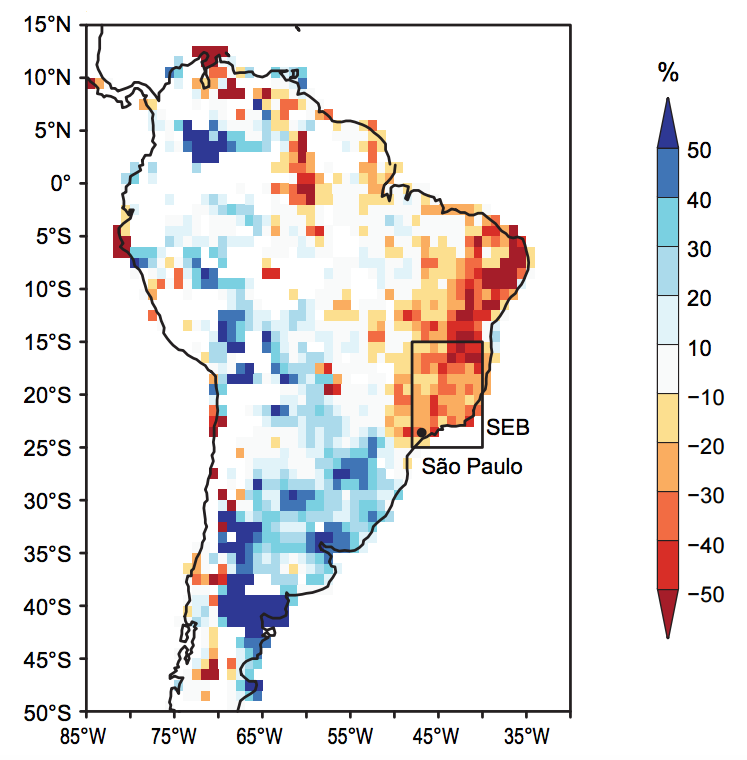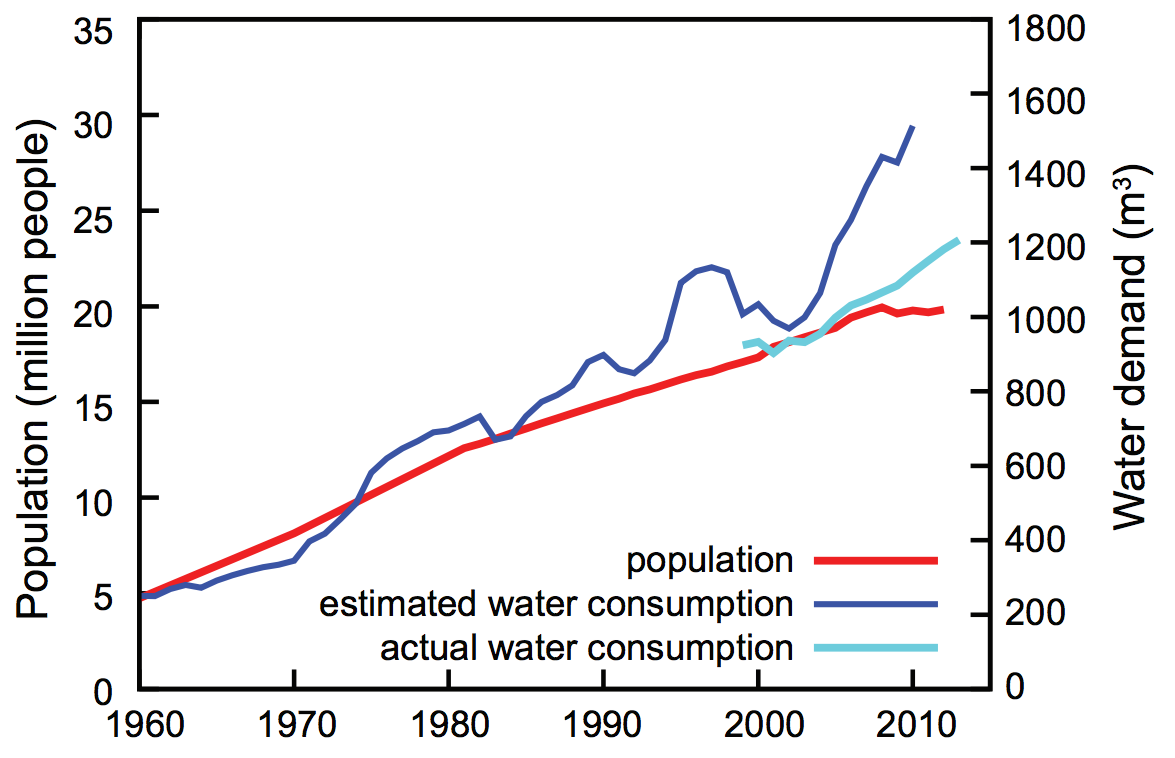Climate change ‘not a major influence’ on Brazil drought, study says
Robert McSweeney
11.06.15Robert McSweeney
06.11.2015 | 2:54pmIncreasing population and demand for water are the main causes behind a major drought in southeastern Brazil in 2014-15, a new study finds.
Using three separate approaches, the researchers find that climate change has not increased the chances of droughts occurring in the region, and that similarly unusual dry periods have occurred in the past.
Extreme events
The new study is published as part of a report from the Bulletin of the American Meteorology Society (BAMS) on extreme weather events across the world in 2014.
The report contains 32 peer-reviewed papers, covering a range of extremes, from a Himalayan snowstorm to an Argentinian heatwave. For some events, such as the record 62-day dry spell in Singapore, researchers find no evidence of a climate change impact.
For others, such as the third hottest spring on record in northern China, the link is clear – greenhouse gases in the atmosphere contributed to an 11-fold increase in likelihood of such hot weather.
Yesterday, Carbon Brief covered one paper that found climate change made the UK’s wet winter of 2013-14 seven times more likely.
Today we take a look at another study, which considers one of the most prominent extreme events of recent years: the drought in southeastern Brazil.
Failed rainy seasons
Southeastern Brazil includes the country’s two largest cities, São Paulo and Rio de Janeiro. After two failed rainy seasons in 2013-14 and 2014-15, water levels in major reservoirs in the region fell to as little as 3-5% of the maximum they can hold.
The drought damaged coffee and sugar crops, caused water shortages that forced schools and health centres to close early, and put the nation’s hydroelectricity generation at risk.
The video below, from a recent NASA study, shows how scientists have been tracking water availability in Brazil via satellite.
The new BAMS study finds that the lack of rainfall was only part of the reason for the dramatic water shortages. The biggest contributor was increasing population and rising demand for water, say the authors.
Water availability
The bulk of southeastern Brazil’s rainfall comes during their summer, from October to March. The source of the rain is what’s known as the South Atlantic Convergence Zone (SACZ). Lead author Dr Friederike Otto, from the University of Oxford, explains to Carbon Brief:
The SACZ is a diagonal precipitation band that extends from the Amazon to the southwestern South Atlantic, which is usually passing over the southeast of Brazil during the rainy season in [their] summer.
But in the last two years, these rains haven’t materialised. For January to March 2014, for example, much of the region had 300mm less rainfall than usual.
Overall, from January 2014 to February 2015, parts of southeastern Brazil received as little as half their expected rainfall. The red shading in the below map below shows the rainfall deficits are concentrated in eastern and southeastern areas of the country.

Map of rainfall over Brazil for January 2014 to February 2015, relative to the 1941-2010 average (in %). Black box identifies study area in southeastern Brazil (“SEB”). Source: Otto et al. (2015).
The researchers used three different approaches to investigate whether climate change contributed to the the water shortages.
The first method considers how the lack of rainfall in 2014 compared with rainfall records in the past – going back to 1941. Using multiple runs of a climate model, the second approach compares water availability in the current climate to a world without human-caused carbon emissions. The third method uses the eight global climate models to estimate whether rising global temperatures have increased the risk of the current drought.
In all three methods, the researchers find that climate change hasn’t been a major influence on the drought. While the lack of rain was unusual, it wasn’t unprecedented, the paper points out, with similar conditions seen during previous major droughts in 1953-54, 1962-63 and 1970-71.
The main reason for the water shortages was rising population and water demand, the study finds. São Paulo alone is home to around 20m people, and population has risen by 20% over the past 20 years, while daily water use – at 180 litres per person – is 50% higher than in Germany.
The chart below from the paper shows how population and water demand have increased in recent decades.

Population of São Paulo metropolitan region (red line) over the period 1960–2012 and estimated (1960–2010, blue) and actual (1999–2013, aqua) water use in Greater São Paulo (area defined slightly differently) over the period 1960–2010. Source: Otto et al. (2015).
Climate change impact
The results of the study actually suggest that climate change has made periods of very dry conditions less likely. But at the same time that the region getting warmer, more moisture is evaporating into the atmosphere. The result is that the two processes cancel each other out, says Otto.
As for why the rains failed in the last two wet seasons, the causes aren’t yet clear, says Otto. High pressure “blocking” weather systems coming in from the Southern Atlantic Ocean diverted away the moisture-bringing low pressure systems. But scientists aren’t sure about the mechanisms behind these blocking systems or if they are likely to happen more because of climate change, Otto adds.
There are other aspects of human activity that could be affecting rainfall in Brazil.
Scientists say that deforestation in the Amazon may be influencing rainfall in Brazil more widely. As trees “sweat” through transpiration, they transfer moisture into the atmosphere – around 20bn metric tons of water per day. This moisture then falls as rain over the Amazon or is carried away on air currents known as aerial rivers.
Removing trees reduces how much water is released to the atmosphere, meaning less moisture is available to become rain. Dr Antonio Nobre, senior researcher at the National Institute of Amazonian Research, who wasn’t involved in the BAMS study, tells Carbon Brief:
In normal years, most of the rainfall feeding the Southeast is carried from the Amazon through the aerial rivers. The link of deforestation with reduced rainfall within the Amazon is well established. One needs only to connect the dots.
You can watch Nobre’s TED Talk on the topic here.
Atmospheric fence
For the moment, rain has returned to the region as the wet season gets started, says Dr Leila Carvalho, an associate professor at the University of California, who is in Brazil at the moment.
The El Niño event currently underway may help alleviate the drought, with slightly above average rainfall expected for São Paulo. El Niño tends to bring heavy rainfall events to southern Brazil, however, rather than more moderate increases, says Carvalho.
The region should be preparing now for more rainfall extremes in the future, Carvalho warns. She tells Carbon Brief:
Megacities like São Paulo will be always the most vulnerable to climatic extremes. Politicians cannot wait to see whether the reservoirs will fill during the next SACZ event or expect that the El Niño will save Sao Pãulo from a major water crises to take action.
Looking further into the future, climate model projections show a divided picture for Brazil, with decreases in rainfall in the North and increases in the South. São Paulo sits on the boundary between the two, says Otto:
The São Paulo region is exactly in the middle of this atmospheric fence, hence it is highly uncertain if the results of this study will hold further into the future than the next decade.
So although climate change may not be affecting droughts now, that might change in the near future.
Main image: Drought in Brazil. © Luiz Ferreira/Shutterstock
-
Climate change ‘not a major influence’ on Brazil drought, study says #BulletinAMS
-
Increasing population and water demand the main causes behind a major drought in SE Brazil in 2014-15 #BulletinAMS


